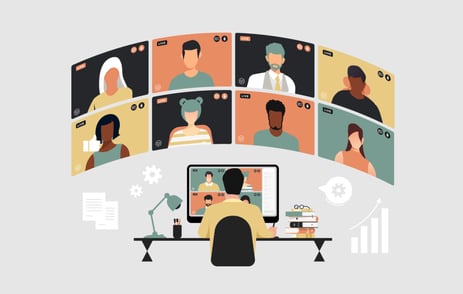Editor's note: This blog post originally ran on Elisa Pratt's LinkedIn page.
Here in the United States, we are potentially in only the early stages of this global health crisis, and I have already reached my limit. Like you, I’m being barraged by literally hundreds of virtual event invitations! I can’t take any more boring webinars, valueless virtual meetings, useless live-streams, disjointed video conference calls, worthless digital briefings, awkward online happy hours and insignificant group “zooms.” It’s no surprise that Zoom’s daily active user count is up 378% compared to March of last year, but this is getting out of hand!
On behalf of digital audiences everywhere, I must register a complaint. Most virtual experiences in which I have participated have been mediocre at best: Bland slide decks, redundant overviews, monotone presenters, 10-minute introductions, protracted and pointless discussions. Please make it stop! I can’t take another month of this, nor can we allow this to become the “new normal.” I don’t pretend to be an expert in digital experience design, but I beg you to reevaluate your virtual content and how you deliver it. I’ll put it bluntly – if your material sucks, it won’t matter how or when you provide it online.
In the scramble to shift to online engagement, many have forgotten that the value is in the content, not the delivery method.
I appreciate that while working from home and sheltering in place, we must gravitate towards digital connections. However, those experiences must be engaging and valuable. Going virtual and engaging your audience in a new way means more than just putting your same old material on the screen. This can’t just be about the technology, or the online transition itself. The objective must be to engage your target audience in a new, sincere, and impactful way. Particularly, when looking to generate revenue from events recently transitioned online or newly digital programming, you must invest in best-in-class content, not just the most impressive technology platform. Inadequate material remains so, irrespective of the delivery method.
In fact, the weaknesses of poor content are in many ways magnified by the online experience.
In this time of “virtualization,” there are four ways to help ensure your virtual event experience is effective and valuable.
1. Don’t Simply Re-purpose : Content previously delivered in person is not automatically ready to go virtual. It requires more than reformatting and uploading to make preexisting content valuable. If your content was outdated or underwhelming before, simply transitioning to online delivery won’t solve your problems. Take the time necessary to critically evaluate preexisting content and determine what will translate, what needs to be evolved to fit the new delivery method, and what needs to be wholly recreated to suit an online platform.
2. Realize You’re Competing: Millions of Americans have shifted to working from home and the number of states issuing stay-at-home and shelter-in-place orders grows each day. You may think your audience is captive or bored and hungry for your content but remember, you and your programming are competing with not only a global pandemic and financial crisis unlike anything we have seen in our lifetimes, but also children at home, possibly ill family members, a barrage of news and information, not to mention the virtual events and digital content offered by everyone else! To cut through the crisis and the increased noise, your content must be relevant. It’s easier to log off a futile webinar than it would have been to leave the room during a subpar in-person session. You audience will get pickier and as certain providers offer more sophisticated online content; expectations will go up.
3. Know Your Technology Tools: Have enough respect for your audience to learn the technology tool you will use. None of us are immune from the failures of an internet connection or the toddler interrupting during a video call, and we can expect more of that than ever as the use of technologies like Zoom skyrockets. However, as a provider of an online experience, virtual event or digital content, it is your obligation to know your environment and how to appropriately use the platform you have asked others to use to join you. Practice your presentation so you can do more than read a slide, engage the tools so you know how to mute your audience and share a screen before the program begins, show your audience you cared enough about their time and their needs. Don’t wing it or assume it will be intuitive. You are asking for your audiences’ time – so invest the time necessary to gain at least a working knowledge of your technology tools.
4. Be Creative: Simply reading slides or remarks from a script during a webinar doesn’t mean you have a digital content strategy. There is no better time than now to get creative and explore new delivery strategies. As thousands of teachers are moving their classrooms online and working to hold the attention of children of all ages and abilities, I have been personally inspired by their efforts. I see educators being creative and funny, using diverse tools and tactics to engage students. This is your chance to take risks. Considering everything going on, there is no greater abundance of leeway and forgiveness than right now. Make the most of this opportunity as you consider virtual engagements.
Recent disruptions almost require online engagement and the virtualization of formerly in-person offerings. However, no matter what these virtual events are called or how they are broadcast, the content must evolve as much, if not more, than the technology tools. Ensure the material is fresh and valuable, relevant and timely, technically professional and interesting.
In closing, I beg you… FOCUS ON THE CONTENT!
Tags:
Events Management
April 28, 2020


